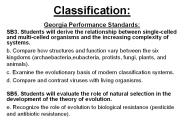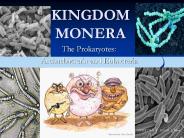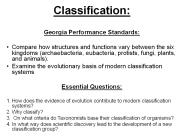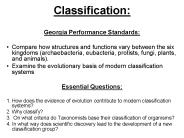Eubacteria PowerPoint PPT Presentations
All Time
Recommended
Bacteria - PBworks ... Eubacteria
| PowerPoint PPT presentation | free to download
Archaebacteria and Eubacteria
| PowerPoint PPT presentation | free to view
Mutualists (bacteria and host both benefit) Unicellular, colonial, filamentous ... phototaxis: movement toward light. chemotaxis: movement to chemicals ...
| PowerPoint PPT presentation | free to download
Archaebacteria and Eubacteria Sarita Bhatia Department of Botany, DAVCG, Yamunanagar.
| PowerPoint PPT presentation | free to view
Archaebacteria and Eubacteria Sunita Kaushik Department of Botany, DAVCG, Yamunanagar.
| PowerPoint PPT presentation | free to view
Kingdoms Archaebacteria and Eubacteria SWBAT list the prime characteristic of organisms in the kingdoms Archaebacteria and Eubacteria; describe two important aspects ...
| PowerPoint PPT presentation | free to view
Archaebacteria and Eubacteria What are bacteria? Bacteria are prokaryotes (no membrane bound nucleus) Smallest living known cells Found Everywhere Characteristics ...
| PowerPoint PPT presentation | free to download
Eubacteria and archaebacteria differ in the presence of a nucleus. the makeup of their cell walls. size. the presence of a cell wall. 5 4 3 2 1 Unlike eubacteria ...
| PowerPoint PPT presentation | free to view
Chloroplasts and Mitochondria (organelles) are believed to originally be ... Evidence:Mitochondria have their own DNA separate ... Facultative. Reproduction ...
| PowerPoint PPT presentation | free to view
Ancient fossils 3.5 billion years b.p. Archetype for prokaryotic organisms. Phototrophs ... Mutualists (bacteria and host both benefit) Unicellular, colonial, ...
| PowerPoint PPT presentation | free to download
Title: PowerPoint Presentation Author: McDougal Littell Last modified by: karen.dent Created Date: 9/14/2006 4:17:10 PM Document presentation format
| PowerPoint PPT presentation | free to view
Eubacteria, Archea, Yeast Cell Walls
| PowerPoint PPT presentation | free to view
Growth: cell enlargement, cell number. Evolution: long term adaptation ... All of these nutritional modes are found among prokaryotes! ...
| PowerPoint PPT presentation | free to download
Eubacteria cells are unicellular, containing just one cell. ... Typhus, Lyme Disease, Scarlet Fever, Strep throat, Rocky Mountain spotted fever, ...
| PowerPoint PPT presentation | free to view
Contain Chlorophyll a and carotenoids, plus the phycobilins (proteinaceous ... Richelia in some pennate diatoms * Nostoc in Anthoceros (Hornworts) ...
| PowerPoint PPT presentation | free to view
Do not have a membrane-bound nucleus ... Tadpole. Many sided (helical or cube-like) Viruses. D. Vary in size (20 - 400 nanometers) ...
| PowerPoint PPT presentation | free to view
Many of them live in places where no other forms of life ... An axial filament (bacteria cell moves like a corkscrew) Slime. How do bacteria cells reproduce? ...
| PowerPoint PPT presentation | free to view
Bonnie Bassler - Eubacteria Unit 2 - Cellular Matter and Energy Flows How matter and energy cycle through the biosphere What you need to understand in this unit The ...
| PowerPoint PPT presentation | free to view
Anton van Leeuwenhoek is given credit for being the first person to observe them ... genes are carried from one bacterial cell into another within a bacteriophage. ...
| PowerPoint PPT presentation | free to view
Eubacteria are
| PowerPoint PPT presentation | free to view
Prokaryotes Kingdoms Eubacteria & Archaebacteria
| PowerPoint PPT presentation | free to view
Classy Kingdoms I am eukaryote I am autotrophic What am I? Fungi Animalia Eubacteria Archeabacteria Plantae Protista Fungi Animalia Eubacteria Archeabacteria Plantae ...
| PowerPoint PPT presentation | free to view
KINGDOMS OF LIFEre 18-13 Cladogram of Six Kingdoms and Three Domains Archaebacteria Section 18-3 Fungi Animalia Plantae Protista Kingdoms Eubacteria Eubacteria
| PowerPoint PPT presentation | free to download
Dr. Alvin Fox * * * * * * * * * * * * * * * * * * Key Words Prokaryotic Outer membrane Eubacteria (Bacteria) Periplasmic space Archaebacteria ...
| PowerPoint PPT presentation | free to download
Classification Go to Section: Kingdom Eubacteria Go to Section: E. coli Streptococcus Cell Type Prokaryote Number of Cells Unicellular Nutrition Autotroph or ...
| PowerPoint PPT presentation | free to view
Compare & contrast the kingdoms Eubacteria and Archaebacteria. Classification Used to: Name Organisms Group organisms in logical order Quick Write: ...
| PowerPoint PPT presentation | free to view
... Cell walls without peptidoglycan Subdivided into 3 groups based on their habitat --- methanogens, thermoacidophiles, & extreme halophiles Eubacteria Come ...
| PowerPoint PPT presentation | free to view
Classification: Georgia Performance ... (archaebacteria,eubacteria, protists, fungi, plants, and animals). ... Compare and contrast viruses with living organisms. SB5.
| PowerPoint PPT presentation | free to download
Classification of living things Taxonomy- The classification of organisms in an ordered system that indicates natural relationships. 6 Kingdoms Eubacteria ...
| PowerPoint PPT presentation | free to download
kingdoms archaebacteria eubacteria protista plantae fungi animalia guess???? kingdoms archaebacteria eubacteria protista plantae fungi animalia guess????
| PowerPoint PPT presentation | free to view
KINGDOM MONERA The Prokaryotes: Archaebacteria and Eubacteria Methanogens These Archebacteria are anaerobes. They make methane (natural gas) as a waste product.
| PowerPoint PPT presentation | free to download
Bacteria: The Monera Kingdom Bacteria are classified into two groups: Eubacteria (true bacteria) and Archaebacteria (Ancient Bacteria). They are autotrophic or ...
| PowerPoint PPT presentation | free to view
Classification Classification CLASSIFICATION is a manmade system for ... The Six Kingdoms Organizing life in infinite varieties Kingdom Eubacteria True bacteria ...
| PowerPoint PPT presentation | free to download
Monera kingdom was recently divided into Archaebacteria and Eubacteria. Shapes: Bacilli: rod-shaped Coccci: sphere-shaped Spirilla: spiral-shaped Chemoheterotrophs ...
| PowerPoint PPT presentation | free to view
Milestones in the Evolution of Life The Ubiquity of Microbes Prokaryotes Two Domains: Eubacteria vs Archaeans ... Animal-like Protists: Protozoans
| PowerPoint PPT presentation | free to view
1. Bacteria contain Ribosomes, a cell membrane and a nucleus. FALSE: Everything in the kingdoms Eubacteria and Archebacteria are prokaryotic.
| PowerPoint PPT presentation | free to view
A: Discovery Channel LIFE Scientific name = Dionaea muscipula Kingdoms! Biology 11 Eubacteria Prokaryotic Autotrophs and Heterotrophs Unicellular Some capable of ...
| PowerPoint PPT presentation | free to view
Background Biologists have long organized living things into large groups called kingdoms. There are six of them: Archaebacteria Eubacteria Protista
| PowerPoint PPT presentation | free to download
MICROBES !!! Bacteria and Viruses Bacteria: Classification and Structure What are the 6 Kingdoms? Archaebacteria Eubacteria Protists Fungi Plants Animals ...
| PowerPoint PPT presentation | free to view
The 6 Kingdom s Archaebacteria ... Eubacteria Staphylococcus aureus Bacillus anthracis E. coli Protist Eukaryotes Most are ... Store food energy as glycogen ...
| PowerPoint PPT presentation | free to view
Ch. 19 Bacteria Notes Review: Kingdom Eubacteria and Archaebacteria; Old Kingdom = Monera Unicellular Prokaryotic, no cellular membranes, no nucleus Auto and ...
| PowerPoint PPT presentation | free to download
Classification The organization of living things DOMAIN ARCHAEA DOMAIN EUKARYA Kingdoms Eubacteria Archaebacteria Protista Plantae Fungi Animalia DOMAIN BACTERIA
| PowerPoint PPT presentation | free to view
What are the 6 Kingdoms of Organisms? What is a cladogram? What are the 5 ways we can determine evolutionary relationships? Archeabacteria, Eubacteria, Protists ...
| PowerPoint PPT presentation | free to download
Is your closet organized? Living things are organized into 6 groups THE 6 KINGDOMS OF LIVING THINGS ARE: Archaebacteria Eubacteria Protista Fungi Plants Animals Why ...
| PowerPoint PPT presentation | free to download
Classification: Georgia Performance Standards: Compare how structures and functions vary between the six kingdoms (archaebacteria, eubacteria, protists, fungi, plants ...
| PowerPoint PPT presentation | free to download
Classification: Georgia Performance Standards: Compare how structures and functions vary between the six kingdoms (archaebacteria, eubacteria, protists, fungi, plants ...
| PowerPoint PPT presentation | free to download
Pathogens & You A pathogen is any disease causing agent Bacteria Viruses Prokaryote No nucleus Circular DNA Kingdom Eubacteria 3 Basic shapes: Bacilli Cocci Spirilla ...
| PowerPoint PPT presentation | free to view
Ch. 27: Bacteria and Archaea Modern/regular/eubacteria and the ancient methanogens Prokaryote cells with cell membranes, cytoplasm/cytosol, DNA in the form of one ...
| PowerPoint PPT presentation | free to view
Ch. 27: Bacteria and Archaea Modern/regular/eubacteria and the ancient methanogens Prokaryote cells with cell membranes, cytoplasm/cytosol, DNA in the form of one ...
| PowerPoint PPT presentation | free to view
KINGDOM EUBACTERI DAN ARKHAE Memahami prinsip-prinsip pengelompokkan makhluk hidup. Menyajikan ciri umum Arkhaebacteria dan Eubacteria, dan peranannya dalam kehidupan.
| PowerPoint PPT presentation | free to download
KINGDOM MONERA MONERA ( EUBACTERIA) Tidak mempunyai membran inti ( karioteka ) sehingga inti selnya dinamakan prokariotik Uniseluler (semuanya ) Mempunyai dinding sel ...
| PowerPoint PPT presentation | free to download
Ch. 18 Microbial Models of DNA Microbes : microscopic organisms like bacteria and viruses, can include fungi and protista Bacteria : kingdoms Eubacteria and ...
| PowerPoint PPT presentation | free to download
Protists on Parade Living things are classified into Six Kingdoms: Eubacteria Archaebacteria Protists Fungi Plants Animals We have discussed bacteria, which fit into ...
| PowerPoint PPT presentation | free to download
... eubacteria, protists, fungi, plants, ... Dichotomous keys http://www.lnhs.org/hayhurst/ips/dichot/index.htm Pamishams Use the dichotomous key to identify the ...
| PowerPoint PPT presentation | free to download
KINGDOM EUBACTERI DAN ARKHAE Memahami prinsip-prinsip pengelompokkan makhluk hidup. Menyajikan ciri umum Arkhaebacteria dan Eubacteria, dan peranannya dalam kehidupan.
| PowerPoint PPT presentation | free to download
6 Kingdoms of Life SOL BIO: 5 a-f The student will investigate and understand life functions of archaebacteria, monerans (eubacteria), protists, fungi, plants, and ...
| PowerPoint PPT presentation | free to view
























































